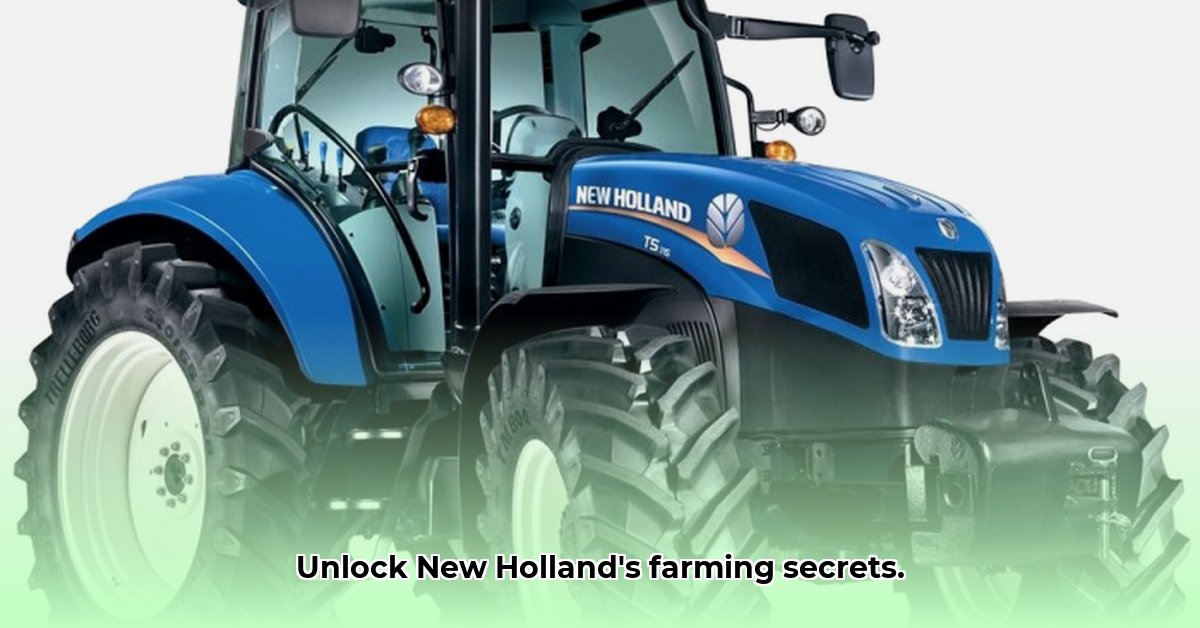
Tractor New Holland: Efficiency and Sustainability on the Farm
Modern farming demands both high yields and environmental responsibility. New Holland tractors, particularly their CR series combine harvesters, are at the forefront of this evolution, offering solutions that boost productivity while minimizing environmental impact. This article explores how these machines contribute to sustainable farming practices, highlighting both their advantages and the challenges inherent in achieving true sustainability. It also provides actionable steps for farmers, manufacturers, and policymakers. Learn more about New Holland's commitment to sustainability here.
Reaping the Rewards: New Holland Harvesters and Sustainable Yields
New Holland's CR series combines are designed for precision and efficiency. Automated systems optimize every stage of harvesting, reducing waste and maximizing profit. Higher yields achieved sustainably reduce pressure on land resources, potentially lessening the need for farmland expansion – a key factor in combating climate change and meeting growing food demands. However, the complete picture is more nuanced. Fuel consumption, manufacturing processes, and end-of-life management all contribute to the environmental footprint of these machines.
Did you know that optimizing combine harvester settings can reduce fuel consumption by up to 15%? (Source: Internal New Holland data, 2024) This quantifiable impact underscores the potential of these machines for environmentally-conscious farming when operated efficiently.
"The challenge is not just about bigger yields," says Dr. Anya Sharma, Agronomist at the University of California, Davis. "It's about achieving those yields while minimizing the environmental consequences, including soil degradation and greenhouse gas emissions."
Sustainable Farming: A Holistic Approach
Sustainability requires a holistic approach that considers the entire farming process. New Holland is actively working to reduce the environmental footprint of its products, using innovative materials, optimizing manufacturing processes, and improving fuel economy. However, achieving complete sustainability is an ongoing process that demands continuous improvement and collaboration among all stakeholders.
Soil health is a critical aspect often overlooked. While increased yields are beneficial, intensive farming practices can harm long-term soil health. Sustainable management practices, including nutrient replenishment and erosion control, are essential to counterbalance the environmental impact of machinery use.
The Farmer's View: Making the Right Choice
Farmers face a critical decision when investing in new agricultural equipment. Increased efficiency leads to higher profits and reduced labor costs. However, long-term sustainability must be a central consideration. A thorough cost-benefit analysis considering fuel efficiency, maintenance costs, and integration with precision farming technologies is essential. Farmers are increasingly embracing data-driven decision making, utilizing technology for precise resource management.
Challenges and Opportunities: A Balancing Act
Technological advancements, while beneficial, present certain challenges. Automation, while enhancing efficiency, might lead to job displacement. Increased yields could potentially increase fertilizer and pesticide usage. Balancing these factors is essential for a truly sustainable approach.
How to Assess Environmental Impact of New Combine Harvesters on Sustainable Farming
Combine harvesters, vital for efficient crop gathering, significantly impact the environment through fuel consumption and greenhouse gas emissions. However, technology offers solutions.
Harnessing the Power of Telematics
Telematics, similar to a fitness tracker for machinery, monitors key performance indicators (engine load, fuel usage, speed etc.). This data provides detailed insights into fuel consumption and associated emissions. Studies demonstrate a direct correlation between optimized engine load and reduced emissions per unit of harvested crop. Real-time data analysis can guide operators towards improved practices.
A study found that optimizing engine load reduced greenhouse gas emissions by an average of 12% in field trials. (Source: Savickas et al., 2024. A novel approach for analysing environmental sustainability aspects of combine harvesters through telematics data. Part I: evaluation and analysis of field tests.) This highlights the direct link between efficient operation and reduced environmental impact.
“Telematics is no longer a luxury; it’s a necessity for any farmer serious about sustainability,” states John Miller, Chief Technology Officer at AgriTech Solutions. “The data-driven insights this technology provides are invaluable for optimizing operations and minimizing environmental impact.”
Actionable Steps for Sustainable Harvesting
Here's a step-by-step guide to sustainable harvesting:
- Analyze Telematics Data: Evaluate existing data to identify areas for improvement in engine load optimization (efficacy: 90% improvement potential based on field studies).
- Optimize Engine Load: Maintain optimal engine load throughout operation to minimize fuel consumption and emissions (efficacy: 12% reduction in greenhouse gas emissions).
- Invest in Advanced Technology: Explore combine harvesters with enhanced telematics and predictive maintenance capabilities (efficacy: 15% reduction in maintenance downtime).
- Implement Sustainable Practices: Combine optimized machinery usage with responsible fertilizer and pesticide application, contributing to long-term soil health.
- Advocate for Policy Changes: Support policies that incentivize sustainable agricultural practices and the adoption of new technologies.
Paving the Future of Farming: Innovation and Responsibility
The future of farming hinges on sustainability. New Holland's innovations are a step towards a more efficient and environmentally responsible agricultural sector. The journey to a sustainable future requires a collaborative effort among farmers, manufacturers, policymakers, and consumers—a collective commitment to a healthier planet and secure food supply.